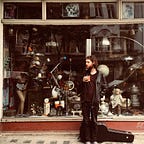The Impact of Music on Emotion
Without a word of French, somehow I still dither on the brink of complete blubbering mess every time I listen to Jacque Brel’s “ne me quitte pas”. The Francophone, chanson singer lays claim to a wide breath of musical influence, with Nina Simone and David Bowie noting him as a key inspiration to their work. The question arises, why does this Belgian born, strange looking, gap toothed singer move me or any Anglophone alike so much? The answer I’ve come to suspect is that some music is like a language all onto itself. Unlike spoken languages, such music operates solely as an emotional dialogue where one emotion expressed brings about a counter emotional affect in the listener. Here, I’ll examine music’s impact on the full emotional spectrum of the human condition. Sex may sell, and, as such, usurp the charts for the most part, but, as we’ll see, music can stir even the darkest, and more subtle crevasses of the our minds.
Music and Murder
Neil Young and the Beach Boys were noted fans of the failed singer, Charles Manson — that is, until he led his “family” to commit an infamous series of murders in Hollywood in the summer of 1969. The story is as dark and depressing as they come, effectively killing the hippy era of the sixties along with the targets of their heinous crimes. Strangely, the cult accredited the Beatles’ music as the true culprit for their actions. The Manson family stated that the Beatles spoke to them via such songs as Blackbird and Helter Skelter, suggesting the group left notes in cryptic lyrics for them to target celebrities and bring about racial war, revolution. This was a clear case of drug-fueled madness, driven by a charismatic, dangerous, and deeply disturbed leader — but, this example also serves to show the power of music’s influence. It can help turn peace loving hippies into aggressive, killing criminals the wrong hands strike a chord.
Sound and Early Development
Leaving lyrics aside, music still manages to hold such sway over our feelings, via emotional responses, as it simply demands our attention more than most other sensations. Unlike taste or smell it’s incredibly difficult to cut off the experience of external sound, completely. If you manage it, by use of ear plugs or, failing that, jamming your fingers in your ears, sound still won’t fully dissipate. Rather, like placing a seashell to your ear, you’re presented with everlasting ocean of sound — namely, the inner workings of the human body. The flow and swirl of the body’s blood, heart beat, pulse and breath calms the mind. A recent study published in American Scientific suggests that the sounds of the inner body could hark the mind back to the earliest stages of hearing development within the womb. With help of a tiny waterproof microphone the researching scientist, Sheila Woodward, demonstrated that the “rhythmic sound of blood coursing through the uterine artery” is heard within the womb, adding “nature allows us to evolve with rhythm all around us”. When external music is played, such as Bach or the mother singing a lullaby the result “is like listening to music underwater”. What’s more, the effect of a mother listening to calming music brings about a similar easing of the infant’s heart rate. The study suggests that the fetus is not only able to hear — albeit distorted or muffled — sound in the womb, but takes cues from the mother’s reactions as how to feel relative to these sounds — growing calmer or more excited as a result.
Tone and Reaction
Perhaps the most poignant example of music’s ability to encapsulate emotion, comes from the bizarre mishmash of NASA scientists and delta blues players. When NASA sent their Voyager probe into space in 1977, researchers such as Carl Sagan put together a golden vinyl record to express a variety of different sounds representative of the human race — in case any hipster extra-terrestrials happened across it with a handy vinyl player. “Dark was the night, cold was the ground”, a song made up of a loan moaning voice accompanied by a single glass bottle dragged along a low tuned guitar played by Blind Willie Johnson, made the cut. The song was chosen as it was said effectively convey the feeling of loneliness. Hearing the song, the choice is starkly effective as you can’t help but feel affected. The ache, moan and pain of the 1920’s bluesman are blatant, and soul-shatteringly beautiful. The vast complexity of humanity’s emotional arch are there plain as day and rich with colour — now floating outside the solar system in dark empty space.
It is true that not all music or art gives rise to an emotive response, and, similarly, aliens, sociopaths and emotionally crippled fungi alike may appreciate expressions of humanity on different levels. However music and art, at their best, are reflections of us. What I find comforting about an emotional response to the music of a bottle being dragged across an old guitar, or the faltering voice of a French language performer aching and breaking with longing, is that music and art, at their best, need no interpretation. Great music simply needs to be heard to be understood. An emotional response to music is a sign this effect has been achieved. All art, then, may just be a reminder that others feel it, too.
